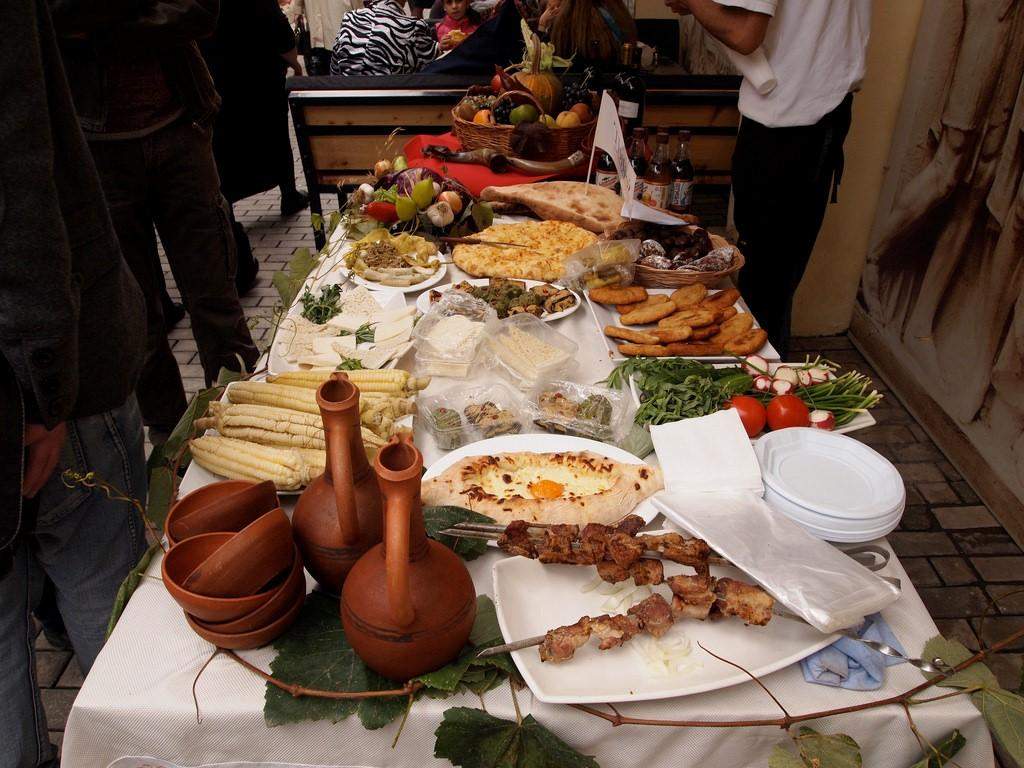The famous ‘Supra’ and the art of winemaking in Georgia


The popularity of the Georgian wine is evident from the fact that it finds its place in the UNESCO Intangible Cultural Heritage List. Georgia is known to be the oldest producer or manufacturer of best quality wines in the whole world. The history says that their wine production dates back up to 8000 years ago. Georgia has almost become synonymous with “wine”. The country’s moderate and humid climate is best suited for wine production.
The traditional Supra
Supra can be said to be the backbone of Georgian culture and has a lot of elements that combine to form a great feast. Supra is a traditional dinner in Georgia that has wine, food and companionship. Though the specifics vary, certain elements of the Supra always remain the same.
The traditional leader of the supra is the Tamada, or toastmaster and he or she always starts with a toast to the country and then to God, followed by a toast to the guests.
Supra is full of delectable food, exquisite wine and enthusiastic conversation and lively people. The responsibility lies on the host to take care of the people and provide over flowing quantity of food and keep refilling. The guests should be tipsy and stomach full in a perfect Supra. The food normally consists of chicken, ham, rice and assorted greens.
Quite often in traditional Supra ceremonies the guests and hosts drink out of horns, either real rams’ horns or porcelain replicas instead of modern glasses..
What comprises Supra?
Supra is comprised of following elements:
Tamada: Tamada is the person permitted to raise toasts and downs his glass of wine after giving each toast. Tamada is expected to keep the toasts and party going and should be prepared to drink most at the table without acting drunk. Under no circumstance can he make a toast with a half full glass. Huge responsibility we say.
Alaverdi: The Tamada may call upon an Alaverdi who is someone designated to extend the toast.
Food: Georgians have a lavish multicourse meal. The food is abundant. Mostly the food has Khachapuri (Georgian cheese bread), Churchkeli (a grape and walnut candy), pork, chicken, eggplant stuffed with walnuts, bread and cheese and loads of sweets or cakes.
Wine: This is the pride of Georgia. The wine is drunk after the Tamada gives the toast.
The Georgian Supras or feasts are often compared to an academy of learning. It is said that this tradition originated from the monastery of Ikhalto, where the abbot used to initiate discourses through toasts. Even today the meal and toasts are many a times used as a means to discuss the deeper questions of life.
The wine making process
Georgians adhere to the complete apparatus and temperature adjustment to the process of fermentation of wine. This leads to the production of a state of the art, semi-dry, sweet and rosé wine. Wine is made out of grapes. Traditionally the grapes were crushed with feet but since the volumes are too large now increasingly machines are used for this purpose.
Traditional Qvevri wine-making is practiced all across the country, especially in village communities. These communities grow unique varieties of grapes. A traditional egg shaped earthen vessel is used for making, ageing and storing the wine. The traditional knowledge of Qvevri and wine-making are passed down through generations.
The wine-making process involves crushing the grapes and pouring the juice, skin and pips into the Qvevri, which are then topped with wooden lid and sealed and buried in the ground to let the wine ferment for over five to six months. The Qvevri usually have a beeswax lining inside as well as are encased with lime on the outside.
Many Georgian families to this day own special places called Marani beside their houses where they bury the Qvevri, with different sizes of kvevries buried.
Wine plays a vital role in everyday life and in the celebration of secular and religious events and rituals. Wine cellars are still considered the holiest place in the family home.
The key benefit of using the Qvevri is that the wine temperatures inside the earth do not differ much in summer and winter seasons and thus optimal temperatures are maintained without any intervention.
The grapes are stored with their skin on so that the wine that is produced is rich in tannins. Since the qvevris are in the form of a pointed cone at the bottom, the seeds and other grape sediments settle at the bottom. The wines produced using this method are CharWine produced using the qvevri is characterized by its unique stability, high potential for aging and distinguished flavor and aroma.
After the completion of fermentation while the grape skins remain floating on the surface due to the carbon dioxide inside the skins, the lees sink to the bottom. Thus the wine remains in contact only with the skins and are thus superior in taste.
Popular wines
The most familiar wines are:
- Kindzmarauli- Red, semi-sweet, made from Saperavi grapes
- Khvanchkara – Red, semi-sweet, made from Alexandrouli and Mudsheretuli grapes
- Mukuzani – Red, dry, made from Saperavi grapes
- Saperavi – Red, dry, made from Saperavi grapes
- Tsinandali – White, made from Rkatsiteli and Mtsvane grapes
- Pirosmani – White, semi-sweet, made from Tsolikauri and Tsitskagrape
The Georgian wine and supra are much loved and is a traditional custom followed since years. Georgians even apply some drops of traditional wine to baby’s lips so that the babies know what their country is so popular for. This is the extent to which they are proud of their heritage.
References:
http://www.georgianjournal.ge/discover-georgia/32146-the-art-of-winemaking-in-georgia.html
https://en.wikipedia.org/wiki/Georgian_wine
http://sweetcsdesigns.com/georgian-supra-traditional-wine-feast/
https://traveldisequilibrium.wordpress.com/2012/10/16/wine-making-a-georgian-tradition/
http://www.wineinmoderation.eu/en/content/History-Tradition-of-Wine.4/
.jpg)